Protection from Pathogens
17 Immune System
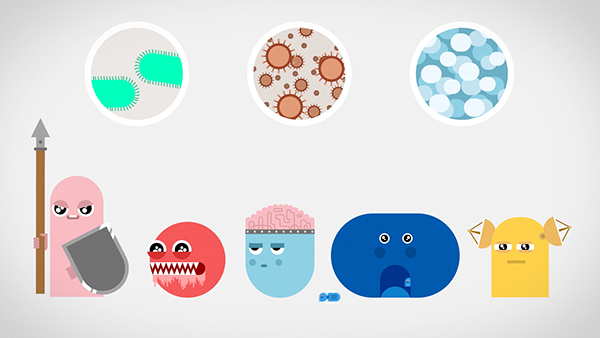
(Credit: Kurzgesagt – In A Nutshell, CC BY NC 4.0)
Introduction to the Immune System
Learning Objective
As the vertebrate immune system evolved, the network of lymphatic vessels became convenient avenues for transporting the cells of the immune system. Cells of the immune system not only use lymphatic vessels to make their way from interstitial spaces back into circulation, but they also use organs of the lymphatic system as major staging areas for the development of critical immune responses. The functioning of these systems allows our bodies to initiate and coordinate an immune response to remove cellular debris, bacteria, toxins, fungi, parasites, and viruses that accumulate in our bodies.
Learn By Doing 17.1
Fact or myth? Read the statements below and see what you think. Once you’ve made your choices, check the feedback at the end of the chapter.
- Lymph accumulates toxic waste products over time, so it is recommended to do lymph cleansings regularly.
- The human immune system has the ability to make up 109 different antibodies.
- The younger we are, the stronger our immune system is.
- Vaccines can cause autism.
- One of the most remarkable features of the immune system is its ability to respond to an apparently limitless array of foreign antigens.
- When you begin to experience the flu or cold symptoms, it is wise to take extra doses of vitamins C and zinc to boost your immune system.
- Only healthy individuals should get the flu shot because you could get the flu from the vaccination.
Let’s start our discussion by examining the Big Ideas of Human Biology and exploring some ways these Big Ideas may be seen in the functioning of the Lymphatic System and in Immunity. These ideas have been identified as common throughout the body systems and will provide secure footing as we continue to build our understanding of these key functions.
- The processes that occur in living organisms follow the laws of physics and chemistry. When molecules and atoms leave tissues and enter the lymph vessels as lymph fluid, the driving forces behind those movements are chemical processes, namely osmosis and diffusion. Movement of the lymph fluid relies on capillary action as wells as differential changes in the pressure on the fluid inside the lymph vessels. The immune function of the lymphatic system uses the partial charges and shapes of larger biomolecules like proteins to determine the fit of a cell surface receptor for a variety of molecules. In the immune and lymphatic system recognition of histocompatibility markers by cell surface receptors and recognition of foreign antigen by the immune cells relies on these underlying properties of molecules
- The cellis the basic unit of life.
A key piece of the lymphatic and immune systems is the bone marrow, which produces white blood cells that can protect the body by attacking pathogens that have entered the blood stream. The bone marrow contains stem cells which are not only capable of replication but remain multi-potent. The division of the stem cells and further differentiation of those daughter cells into functioning cells of the immune system allows the body to defend against foreign invaders as well as monitor cells which may have change and are growing in way which could disrupt homeostasis. - Life requiresinformation flowwithin and between cells and between the environment and the organism.
The cornerstone of the immune system is its ability to distinguish self from non-self, in the molecular sense. Once the recognition has occurred, multiple waves of information within the cells and between cells take place, mobilizing immune cells and provoking changes in them in order to attack and destroy the invader. In addition, damaged tissues and cells release signaling molecules which activate not only other cells but also protein cascades which promote blood clotting, wound healing and activation of a several kinds of cells which may be involved in the immune response. - Living organisms must obtain matter and energy from the external world. Matter and energy are transformed and transferred in different ways to build the organism and to perform work.
Energy ingested and digested can be stored as high energy molecules like ATP but can also be used to construct large biological molecules like those found in and on cell membranes, as well as RNA and DNA. Cell functioning requires proper transcription and translation of the DNA and well as accurate replication of the DNA when the cell divides–in other words, the DNA runs the machinery of the cell. In the lymphatic system that energy is used for the replication of cells to build and maintain the lymphatic vessels, the cells of the immune system which fight pathogens directly and the cellular manufacture of antibodies which are proteins and require energy for their manufacture. Additionally, some degree of fever is beneficial for the immune response as it enhances metabolism, and that way increases the activity of the cells. - Homeostasis (and “stability” in a more general sense) maintains the internal environment in a more or less constant state compatible with life.
The lymphatic system contributes to homeostasis in several ways. The lymph and lymph vessels drain away excess fluid and molecules which could contribute to edema and swelling disrupting tissue integrity. The immune response helps to neutralize pathogens which may not only disrupt homeostasis on a local tissue level but could result in a systemic disruption as well. Likewise, loss of control of lymphatic functions which would normally contribute to maintaining homeostasis can also lead themselves to a disruption of homeostasis. Inflammation should stop as soon as it is not necessary anymore, because the presence of those powerful molecules may cause damage to tissues. Many conditions are caused by an inflammatory process that goes on, such as rheumatoid arthritis or Crohn’s disease. - Understanding the functioning of the human body requires understanding the relationship betweenstructure and function(at each and every level of organization).
Lymphatic vessels have larger openings than blood vessels allowing them to pick up and transport larger molecules back to blood circulation. B lymphocytes with a small cytoplasm become, upon the right stimulus, plasma cells with large amounts of rough endoplasmic reticulum churning out amazing amounts of antibodies. A set of small plasma proteins, called complement, self-assemble to form a deadly ring that opens a hole in the membranes of invading cells. Lymph nodes and and the spleen have much larger total cross-sectional areas than the vessels feeding into them. This structural arrangement decreases the velocity of flow through these structures, providing more time to detect and react with foreign pathogens. - Living organisms carry out functions at many different levels of organization simultaneously (at the same time).
Generally speaking the molecules of the immune system, antibodies, complement, cell surface receptors, cell recognition molecules and pathogen recognition molecules stimulate a response within the appropriate cells of the immune system. The cellular immune responses may result in changes to the affected tissues such those found associated with the inflammatory response. The lymph fluids, lymph vessels and other specialized lymph structures continue to support the immune response while also providing a means for the tissues to remove excess fluids, cellular debris and dead and dying cells and pathogens. - All life exists within anecosystemmade up of the physiochemical and biological worlds.
The body can be viewed as interacting with two ecosystems, 1) the external ecosystem of the world around us and 2) the internal ecosystem, which contains symbiotic bacteria and in which your cells and tissues must function. The lymphatic system serves at the interface of both those ecosystems. The immune function modulates the impact that other organisms living in the external ecosystem may have as pathogens. The lymphatic impact on the internal ecosystem involves not only immune function but includes the inflammatory response to tissue injury, the transport of large lipid molecules away from the digestive system and helping to maintain fluid and molecular balances for a healthy internal ecosystem. - Evolution provides a scientific explanation for the history of life on Earth and the mechanisms by which changes to life have occurred.
The lymphatic and immune systems have become more complex during evolution. But even in the context of the immune response, we can observe examples of evolutionary changes. For one, many microbes mutate (change) in a short time, provoking the immune system to develop a new response each time (ever wondered why you need a new flu shot every year?) On the other hand, the antibodies produced during the immune response can also be switched to be complementary to new antigens, resulting in more effective antibodies. Humans live with organisms inside their internal environment as well as free-living organisms found in the external environment. Random mutation in genetic material is the source for change in an organism or species. Most mutations are either neutral or deleterious. A very small percentage of mutations result in a new trait or character which allows that organism to thrive in a changing environment. Organisms that have rapid reproductive cycles can change much more quickly as a species than organisms that have a long reproductive cycle. In bacteria, the reproductive cycle is often hours compared to humans which may be 20+ years. The lymphatic system can adapt to changes in pathogenic organisms by rearranging the genes used to make antibodies, activating a different clone of lymphocytes, or altering the expression of cell surface molecules on white blood cells.
Our body is in constant exchange with the environment through breathing, eating, and other activities. Therefore, it is important to screen the body and its components regularly to identify foreign invaders that might enter during these activities (or in any other manner). Further, it is important to rapidly and effectively remove these invaders before they can cause significant harm. Our body has specialized transport systems to carry out these functions. The cardiovascular and lymphatic systems work together to transport excess fluids (blood and lymph fluid, respectively) away from body tissues. The cardiovascular and lymphatic systems also participate in the function of immunity, helping defend the body’s cells from foreign organisms that may enter the body tissues or fluids.
Learn By Doing 17.2
Immunity requires a variety of fully functioning cells to provide the best protection. When someone is undergoing chemotherapy, they often experience a decrease in their immune functions as a result of their treatment. Since the cell is the basic unit of life, which of the following is most likely affected?
- Chemotherapy inhibits the growth of immune cells by reducing their ability to produce needed molecules.
- Living things reproduce themselves and chemotherapy inhibits the ability of some key cells such as lymphocytes and the epithelium of mucus membranes to divide quickly in response to damage and/or to invaders.
- Living things have complex structures and chemotherapy results in the evolution of cells which are highly simplified.
- Living things need to be able to undergo metabolism, and chemotherapy starves the cells.
The immune system monitors and provides information about the external world as well as the changes and perturbations of the body’s internal environment. In addition to immune reactions, the inflammatory process prevents further internal damage and promotes repair. How are these responses triggered? Pick the best answer.
- In response to noxious stimuli such as extreme heat or cold, damaged cells and immune surveillance cells initiate a local inflammatory response.
- Damaged tissues found internally such as ruptured endothelial cells or torn muscles and ligaments release chemical signals in the local area which stimulate nearby cells to trigger an inflammatory response.
- Bacterial toxins released into the bloodstream circulate throughout the body and reach the brain where they stimulate systemic responses such as fever, fatigue, anorexia, and irritability.
- One of 1, 2, or 3 is incorrect.
- 1, 2, and 3 are all correct.
The phrase “You are what you eat.” has been bantered around for a long time. In terms of immune functions, why would what you eat matter?
- The lymphatics in the digestive system called lacteals pick up the fats you have eaten and degrade them so that you don’t get too many calories.
- Actually, it doesn’t matter; even people who are malnourished have adequately functioning immune systems.
- All of the body’s cells and tissues need energy to grow, repair themselves and reproduce. Without ingesting adequate amounts of fuel the cells of the lymphatic system would not be able to make antibodies, cytotoxic T cells, or maintain the integrity of physical and chemical barriers.
- If you eat too many high-fat foods, the cells in the immune system turn into adipocytes.
Structure and Function of the Immune System
The human immune system is a complex, multilayered system for defending against external and internal threats to the integrity of the body. The environment consists of numerous pathogens, which are agents that cause disease in their hosts. A host is an organism that is invaded and often harmed by a pathogen. Pathogens include bacteria, protists, fungi, and other infectious organisms. We are constantly exposed to pathogens in food and water, on surfaces, and in the air. Mammalian immune systems evolved for protection from such pathogens; they are composed of an extremely diverse array of specialized cells and soluble molecules that coordinate a rapid and flexible defense system capable of providing protection from a majority of these disease agents.
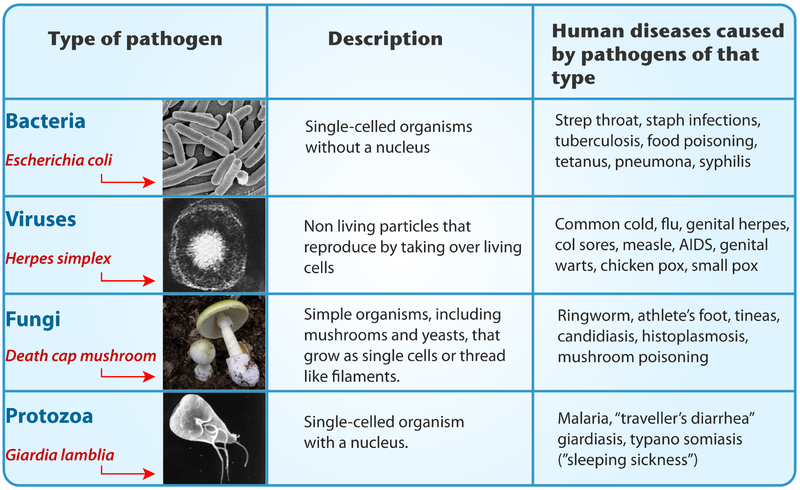
Learn By Doing 17.3
Distinguish between the terms host and pathogen.
The Organization of Immune Function
Components of the immune system constantly search the body for signs of pathogens. When pathogens are found, immune factors are mobilized to the site of an infection. The immune factors identify the nature of the pathogen, strengthen the corresponding cells and molecules to combat it efficiently, and then halt the immune response after the infection is cleared to avoid unnecessary host cell damage. The immune system can remember pathogens to which it has been exposed to create a more efficient response upon re-exposure. This memory can last several decades. Features of the immune system, such as pathogen identification, specific response, amplification, retreat, and remembrance are essential for survival against pathogens. The immune response can be classified as either innate or adaptive, although both arms of the immune system interact. The innate immune response is present at birth and is always active. It attempts to defend against all pathogens rather than focusing on specific ones. Conversely, the adaptive (or acquired) immune response stores information about past infections and mounts pathogen-specific defenses.
The immune system is a collection of barriers, cells, and soluble proteins that interact and communicate with each other in extraordinarily complex ways. The modern model of immune function is organized into three phases based on the timing of their effects. The three phases are the following:
- Barrier defenses such as the skin and mucous membranes act instantaneously to prevent pathogenic invasion into the body tissues
- The rapid but nonspecific innate immune response, which consists of a variety of specialized cells and soluble factors
- The slower but more specific and effective adaptive immune response, which involves many cell types and soluble factors, but is primarily controlled by white blood cells (leukocytes) known as lymphocytes, which help control immune responses.
| Vertebrate Immunity | ||
| Innate Immune System | Adaptive Immune System | |
| Barriers (1st line of defense) |
Internal Defenses (2nd line of defense) |
|
|
|
|
The cells of the blood, including all those involved in the immune response, arise in the bone marrow via various differentiation pathways from hematopoietic stem cells. In contrast with embryonic stem cells, hematopoietic(heme = blood, poieo = create) stem cells are present throughout adulthood and allow for the continuous differentiation of blood cells to replace those lost to age or function. These cells can be divided into three classes based on function:
- Phagocytic cells ingest pathogens to destroy them
- Lymphocytes specifically coordinate the activities of adaptive immunity
- Cells contain cytoplasmic granules that help mediate immune responses against parasites and intracellular pathogens such as viruses.
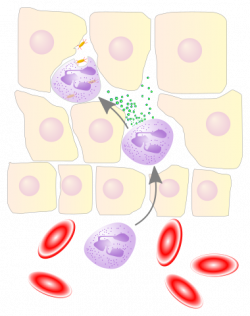 Although the immune system is characterized by circulating cells throughout the body, the regulation, maturation, and intercommunication of immune factors occur at specific sites. The blood circulates immune cells, proteins, and other factors throughout the body. Approximately 0.1 percent of all cells in the blood are leukocytes, which include monocytes (the precursor of macrophages) and lymphocytes. Most cells in the blood are red blood cells. Using a process called extravasation (extra = out, vas = vessel), cells of the immune system can travel between the distinct lymphatic and blood circulatory systems, which are separated by interstitial (inter = between, stitium = place) space.
Although the immune system is characterized by circulating cells throughout the body, the regulation, maturation, and intercommunication of immune factors occur at specific sites. The blood circulates immune cells, proteins, and other factors throughout the body. Approximately 0.1 percent of all cells in the blood are leukocytes, which include monocytes (the precursor of macrophages) and lymphocytes. Most cells in the blood are red blood cells. Using a process called extravasation (extra = out, vas = vessel), cells of the immune system can travel between the distinct lymphatic and blood circulatory systems, which are separated by interstitial (inter = between, stitium = place) space.
Learn By Doing 17.4
It is useful to think about the immune system in terms of those aspects with which we are born and those that we acquire later referred to as acquired or adaptive immunity. Which of the processes below do not fit into the category of innate immunity?
- Destruction of an invading organism by the complement system
- Manufacturing antibodies as the result of getting a vaccination
- Phagocytosis of foreign invaders by macrophages or other cells
- Mechanical and chemical barriers such as sticky mucus membranes and your tears.
What are two main differences between the innate and adaptive immune responses?
- Inflammatory response and lysis of pathogens by phagocytic cells.
- Time of the immune response due to the immunologic specificity and immunologic memory.
- The cells involved and the location of responses.
- Adaptive responses occur in the lymph node while innate responses occur in the blood.
Innate Immunity
Learning Objectives
- Describe the body’s innate physical and chemical defenses.
- Explain the inflammatory response.
- Describe the complement system.
Innate immunity is not caused by an infection or vaccination and depends initially on physical and chemical barriers that work on all pathogens, sometimes called the first line of defense. The second line of defense of the innate system includes chemical signals that produce inflammation and fever responses. These molecules also mobilize protective cells and other chemical defenses. The adaptive immune system mounts a highly specific response to substances and organisms that do not belong in the body. The adaptive system takes longer to respond and has a memory system that allows it to respond with greater intensity should the body re-encounter a pathogen even years later.
External and Chemical Barriers
The body has significant physical barriers to potential pathogens. The skin contains the protein keratin, which resists physical entry into cells. Other body surfaces, particularly those associated with body openings, are protected by mucous membranes. The sticky mucus provides a physical trap for pathogens, preventing their movement deeper into the body. The openings of the body, such as the nose and ears, are protected by hairs that catch pathogens, and the mucous membranes of the upper respiratory tract have cilia that constantly move pathogens trapped in the mucus coat up to the mouth.
The skin and mucous membranes also create a chemical environment that is hostile to many microorganisms. The surface of the skin is acidic, which prevents bacterial growth. Saliva, mucus, and the tears of the eye contain lysozyme, an enzyme that breaks down bacterial cell walls. The stomach secretions create a highly acidic environment, which kills many pathogens entering the digestive system.
Finally, the surface of the body and the lower digestive system have a community of microorganisms (flora) such as bacteria, archaea, and fungi that coexist without harming the body. There is evidence that these organisms are highly beneficial to their host, combating disease-causing organisms and out-competing them for nutritional resources provided by the host body. Despite these defenses, pathogens may enter the body through skin abrasions or punctures or by collecting on mucosal surfaces in large numbers that overcome the protection of mucus or cilia.
The table below summarizes the body’s barrier defenses.
| Site | Specific defense |
| Skin surface | unbroken, waterproof barrier |
| Sweat glands & sebaceous glands of the skin | Low pH, washing action, |
| Oral cavity, Salivary glands | Lysozyme |
| Stomach | Stomach Acid, Low pH |
| Mucosal surfaces | Mucus traps pathogens |
| Normal flora on the skin and mucosal membranes (nonpathogenic bacteria) |
Out-compete pathogens for resources and so prevent them from growing |
Internal Defenses

When pathogens enter the body, the innate immune system responds with a variety of internal defenses. These include the inflammatory response, phagocytosis, natural killer cells, and the complement system. White blood cells in the blood and lymph recognize pathogens as foreign to the body. A white blood cell is larger than a red blood cell, is nucleated, and is typically able to move by reorganizing its cytoskeleton. Because they can move on their own, white blood cells can leave the blood to go to infected tissues. For example, a monocyte is a type of white blood cell that circulates in the blood and lymph and develops into a macrophage after it moves into infected tissue. A macrophage is a large cell that engulfs foreign particles and pathogens. Mast cells are produced in the same way as white blood cells, but unlike circulating white blood cells, mast cells take up residence in connective tissues and especially mucosal tissues. They are responsible for releasing chemicals in response to physical injury. They also play a role in the allergic response, which will be discussed later in the chapter.
The table below summarizes the role of various white blood cells in innate immunity.
| Cell | Function |
| Mast cell | release chemicals to initiate an immune response and orchestrate an allergic response |
| Macrophages | phagocytosis of pathogen and release cytokines to orchestrate an immune response |
| Neutrophils | phagocytosis of pathogen |
| Eosinophils | destruction of worm parasites and abundant in allergic response |
| Basophils | release chemicals to initiate an inflammatory response |
| Natural Killer (NK) cells | release chemicals to kill virally infected cells and cancer cells |
| Dendritic cells | phagocytosis and presentation of the pathogen as a bridge between innate and adaptive immune responses |
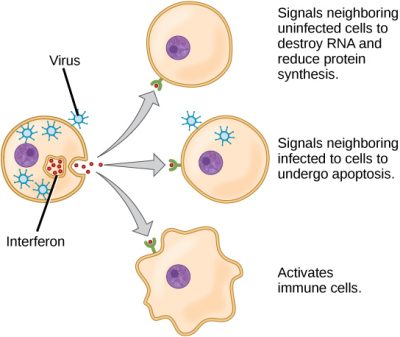
When a pathogen is recognized as foreign, chemicals called cytokines are released. Acytokineis a chemical messenger that regulates cell differentiation (form and function), proliferation (production), and gene expression to produce a variety of immune responses. Approximately 40 types of cytokines exist in humans. In addition to being released from white blood cells after pathogen recognition, cytokines are also released by the infected cells and bind to nearby uninfected cells, inducing those cells to release cytokines. This positive feedback loop results in a burst of cytokine production.
Interferons are one class of early-acting cytokines that are released by infected cells as a warning to nearby uninfected cells. Aninterferonis a small protein that signals a viral infection to other cells. The interferons stimulate uninfected cells to produce compounds that interfere with viral replication. Interferons also activate macrophages and other cells.
The Inflammatory Response and Phagocytosis
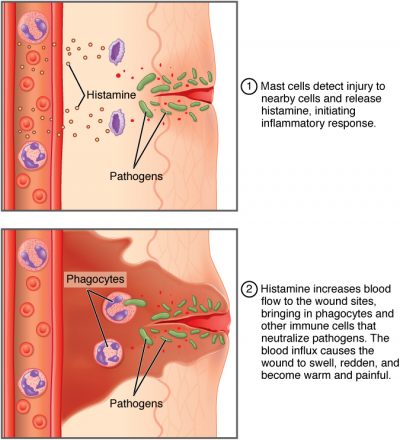
The first cytokines to be produced encourage inflammation. Inflammation is a response to physical trauma, such as a cut or a blow, chemical irritation, and infection by pathogens (viruses, bacteria, or fungi) and is characterized by redness, swelling, heat, and pain. The chemical signals that trigger an inflammatory response enter the extracellular fluid and cause capillaries to dilate (expand) and capillary walls to become more permeable or leaky. The serum and other compounds leaking from capillaries cause swelling of the area, which in turn causes pain. Various kinds of white blood cells are attracted to the area of inflammation. The types of white blood cells that arrive at an inflamed site depend on the nature of the injury or infecting pathogen. For example, the neutrophil is an early-arriving white blood cell that engulfs and digests pathogens. Neutrophils are the most abundant white blood cells of the immune system. Macrophages follow neutrophils and take over the phagocytosis function. They are involved in the repair of an inflamed site, cleaning up cell debris and pathogens.
Cytokines also send feedback to cells of the nervous system to bring about the overall symptoms of feeling sick, which include lethargy, muscle pain, and nausea. Cytokines also increase the core body temperature, causing a fever. The elevated temperatures of a fever inhibit the growth of pathogens and speed up cellular repair processes. For these reasons, suppression of fevers should be limited to those that are dangerously high.
Natural Killer Cells
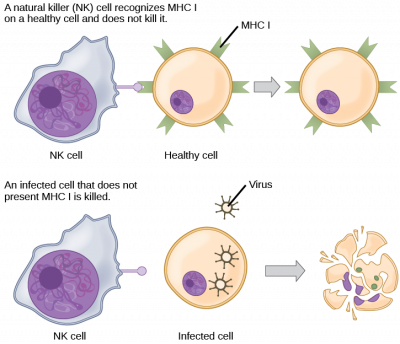 A lymphocyte is a white blood cell that contains a large nucleus. Most lymphocytes are associated with the adaptive immune response, but infected cells are identified and destroyed by natural killer cells, the only lymphocytes of the innate immune system. A natural killer (NK) cell is a lymphocyte that can kill cells infected with viruses (or cancerous cells). NK cells identify intracellular infections, especially from viruses, by the altered expression of major histocompatibility class1 (MHC 1) molecules on the surface of infected cells. MHC class 1 molecules are proteins on the surfaces of all nucleated cells that provide a sample of the cell’s internal environment at any given time. Unhealthy cells, whether infected or cancerous, display an altered MHC class 1 protein on their cell surfaces.
A lymphocyte is a white blood cell that contains a large nucleus. Most lymphocytes are associated with the adaptive immune response, but infected cells are identified and destroyed by natural killer cells, the only lymphocytes of the innate immune system. A natural killer (NK) cell is a lymphocyte that can kill cells infected with viruses (or cancerous cells). NK cells identify intracellular infections, especially from viruses, by the altered expression of major histocompatibility class1 (MHC 1) molecules on the surface of infected cells. MHC class 1 molecules are proteins on the surfaces of all nucleated cells that provide a sample of the cell’s internal environment at any given time. Unhealthy cells, whether infected or cancerous, display an altered MHC class 1 protein on their cell surfaces.
The NK cell can detect abnormal cell surface molecules produced by virally infected and tumor cells. The NK cell then induces programmed cell death, or apoptosis. Phagocytic cells follow and digest the cellular debris left behind. NK cells are constantly patrolling the body and are an effective mechanism for controlling potential infections and preventing cancer progression.
Complement
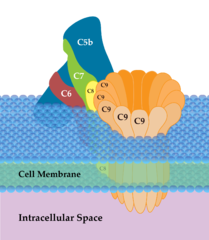
(Credit: SLiva2016, CC BY-SA 3.0)
An array of approximately 20 types of proteins, called the complement system, is also activated by infection and by the activity of the cells of the adaptive immune system. It functions to destroy extracellular pathogens. Liver cells and macrophages synthesize inactive forms of complement proteins continuously. These proteins are abundant in the blood serum and are capable of responding immediately to infecting microorganisms. The complement system is so named because it is complementary to the innate and adaptive immune system. Complement proteins bind to the surfaces of microorganisms and are particularly attracted to pathogens that are already tagged by the adaptive immune system. This “tagging” involves the attachment of specific proteins called antibodies (discussed in detail later) to the pathogen. When they attach, the antibodies change shape providing a binding site for one of the complement proteins. After the first few complement proteins bind, a cascade of binding in a specific sequence of proteins follows in which the pathogen rapidly becomes coated in complement proteins.
Complement proteins perform several functions, one of which is to serve as a marker to indicate the presence of a pathogen to phagocytic cells and enhance engulfment. Certain complement proteins can combine to open pores in microbial cell membranes and cause lysis of the cells.
Summary
The innate immune system consists first of physical and chemical barriers to infection including the skin and mucous membranes and their secretions, ciliated surfaces, and body hairs. The second line of defense is an internal defense system designed to counter pathogenic threats that bypass the physical and chemical barriers of the body. Using a combination of cellular and molecular responses, the innate immune system identifies the nature of a pathogen and responds with inflammation, phagocytosis, cytokine release, destruction by NK cells, or the complement system.
Learn By Doing 17.5
Complete the paragraph by replacing each number with a selection from its numbered column in the table.
Immunity is resistance to disease resulting from the presence of foreign substances or ___1___in the body. If a pathogen gets past the ___2___of the innate immune system, ___3___can ingest and degrade the substance. This process is called ___4___. Because pathogens are likely to use both blood and ___5___as a means of getting around in the body, the lymph tissues and organs are in an excellent position to detect their presence.
|
1 |
2 |
3 |
4 |
5 |
| antibodies | chemical | lymphocytes | inflammation | air |
| antigens | physical | macrophages | phagocytosis | lymph |
| cytokines | physical and chemical barriers | NK cells | margination | saliva |
Which of the following cells would be most active in early antiviral immune responses the first time one is exposed to a pathogen?
- macrophage
- T cell
- neutrophil
- natural killer cell
Complete the paragraph by replacing each number with a selection from the numbered column in the table.
Complement is a system of plasma __1__ that circulates in the blood in an inactive form. Complement is __2__ when it becomes attached to the surface of foreign cells (bacteria, fungi, red blood cells). One result of this complement fixation is that ___3___ appear in the membrane of the foreign cell. This allows __4__ to rush into the cell, which causes __5__ of the foreign cell. Some of the molecules released during complement fixation enhance phagocytosis. Other molecules amplify the inflammatory response.
|
1 |
2 |
3 |
4 |
5 |
| carbohydrates | denatured | holes or pores | water | apoptosis |
| lipids | inactivated | new mRNA or proteins | extracellular fluid | dehydration |
| steroids | activated | self markers (antigens) | sodium | cell division |
| proteins | digested | molecular bridges & cross-linking | white blood cells | lysis |
We often take over-the-counter anti-inflammatory medicines to help us feel better when we are sick or injured. However, the inflammatory response is important after injury in our fight against infection and tissue repair and recovery. Which statement is NOT true concerning the inflammatory response?
- Heat and redness indicate that your inflammatory response is out of whack and the tissue will not heal.
- Pain reminds us to get an injured or infected body part immobile, so we don’t spread the infection or exacerbate the injury.
- Increasing body temperature via fever makes it difficult for some organisms to grow.
- Swelling and edema provide a more fluid environment, which allows white blood cells easier access to the site of infection or injury.
Innate immunity describes immunity that is non-specific to the pathogen or invading organism. Which of the following mechanisms are ALL considered innate immunity?
- Fever, the inflammatory reaction, antibody production
- Inflammatory response, phagocytosis, fever
- Sequestering of pathogens, anatomical barriers, phagocytosis
- Antibody production, fever, anatomical barriers, the inflammatory process
Describe the innate immune response to bacteria that enters through a cut on the skin.
Why is it beneficial to have an innate immune response?
Adaptive Immunity
Learning Objectives
- Explain adaptive immunity
- Describe the cell-mediated immune response and humoral/antibody-mediated immune response
The adaptive, or acquired, immune response takes days or even weeks to become established—much longer than the innate response; however, adaptive immunity is more specific to an invading pathogen. Adaptive immunity is immunity that occurs after exposure to an antigen either from a pathogen or a vaccination. An antigen is a molecule that stimulates a response in the immune system. This part of the immune system is activated when the innate immune response is insufficient to control infection. In fact, without information from the innate immune system, the adaptive response could not be mobilized. There are two types of adaptive responses: the cell-mediated immune response, which is controlled by activated T cells, and the humoral or antibody-mediated immune response, which is controlled by activated B cells and antibodies. Activated T and B cells whose surface binding sites are specific to the molecules on the pathogen greatly increase in numbers and attack the invading pathogen. Their attack can kill pathogens directly, or they can secrete antibodies that enhance the phagocytosis of pathogens and disrupt the infection. Adaptive immunity also involves a memory to give the host long-term protection from reinfection with the same type of pathogen; on re-exposure, this host memory will facilitate a rapid and powerful response.
B and T Cells
Lymphocytes, which are white blood cells, are formed with other blood cells in the red bone marrow found in many flat bones, such as the shoulder or pelvic bones. The two types of lymphocytes of the adaptive immune response are B and T cells. Whether an immature lymphocyte becomes a B cell or a T cell depends on where in the body it matures. The B cells remain in the bone marrow to mature (hence the name “B” for “bone marrow”), while T cells migrate to the thymus, where they mature (hence the name “T” for “thymus”).
Maturation of a B or T cell involves becoming immunocompetent, meaning that it can recognize, by binding, a specific molecule or antigen. During the maturation process, B and T cells that bind too strongly to the body’s own cells are eliminated in order to minimize an immune response against the body’s own tissues. Those cells that react weakly to the body’s own cells but have highly specific receptors on their cell surfaces that allow them to recognize a foreign molecule, or antigen, remain. Antigens that are present inside body cells are called endogenous or self-antigens. Foreign or exogenous antigens may be viral proteins produced after a virus infects the cell, toxins produced from intracellular bacteria, or abnormal proteins synthesized by a cancerous cell. When a peptide fragment comes from a self-protein, T cells ignore it.
The process of B and T cells becoming immunocompetent occurs during fetal development and continues throughout life. The specificity of the receptors is determined by the genetics of the individual and is present before a foreign molecule is introduced to the body or encountered. Thus, it is genetics and not experience that initially provides a vast array of cells, each capable of binding to a different specific foreign molecule. Once they are immunocompetent, the T and B cells will migrate to the spleen and lymph nodes where they will remain until they are called on during infection. B cells are involved in the humoral immune response, which targets pathogens loose in blood and lymph, and T cells are involved in the cell-mediated immune response, which targets infected cells.
Learn By Doing 17.6

In the diagram, where do pluripotent WBC stem cells come from?
- A
- B
- C
- D
- None of these choices
In the diagram, where do T cells mature?
- A
- B
- C
- D
- None of these choices
Where are T cell receptors that are self-directed deleted?
- thymus
- lymph node
- lymph capillary
- bone marrow
Humoral (or Antibody)-Mediated Immune Response
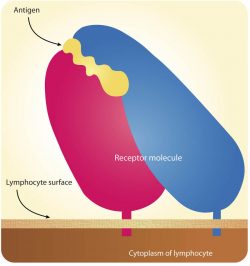
(Credit: Hana Zavadska , CK-12 CC BY-NC 3.0)
As mentioned, an antigen is a molecule that stimulates a response in the immune system. Not every molecule is antigenic. B cells participate in a chemical response to antigens present in the body by producing specific antibodies that circulate throughout the body and bind with the antigen whenever it is encountered. This is known as the humoral immune response. As discussed, during the maturation of B cells, a set of highly specific B cells are produced that have many antigen receptor molecules in their membrane.
Each B cell has only one kind of antigen receptor, which makes every B cell different. Once the B cells mature in the bone marrow, they migrate to lymph nodes or other lymphatic organs. When a B cell encounters the antigen that binds to its receptor, the antigen molecule is brought into the cell by endocytosis and reappears on the surface of the cell bound to an MHC class II molecule. When this process is complete, the B cell is sensitized. In most cases, the sensitized B cell must then encounter a specific kind of T cell, called a helper T cell, before it is activated. The helper T cell must already have been activated through an encounter with the antigen (discussed below).
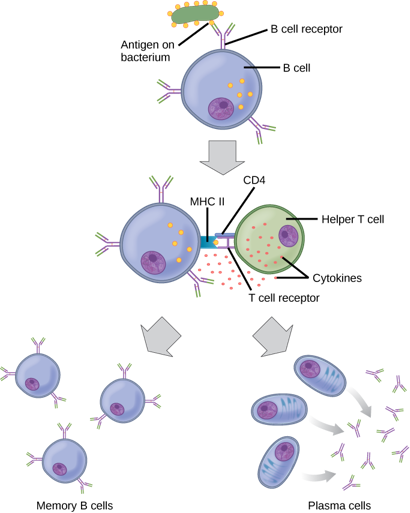
The helper T cell binds to the antigen-MHC class II complex and is induced to release cytokines that in turn direct the B cell to divide rapidly, which makes thousands of identical (clonal) cells via mitosis. This process is called clonal expansion. These daughter cells become either plasma cells or memory B cells. The memory B cells remain inactive at this point. If the same antigen is encountered in the future because of reinfection by the bacteria or virus, the memory B cell rapidly divides into a new population of plasma cells. During the initial infection, the plasma cells produce and secrete large quantities, up to 100 million molecules per hour, of antibody molecules. An antibody, also known as an immunoglobulin (Ig), is a protein that is produced by plasma cells after stimulation by an antigen. Antibodies are the agents of humoral immunity. Antibodies occur in the blood, in gastric and mucus secretions, and in breast milk. Antibodies in these bodily fluids can bind pathogens and mark them for destruction by phagocytes before they can infect cells.
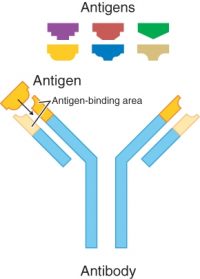
These antibodies circulate in the bloodstream and lymphatic system and bind with the antigen whenever it is encountered. The binding can fight infection in five ways. First, antibodies can bind to viruses or bacteria and interfere with the chemical interactions required for them to infect or bind to other cells. Second, the antibodies may create bridges between different particles containing antigenic sites clumping them all together and preventing their proper functioning. Third, the antigen-antibody complex stimulates the complement system described previously, destroying the cell bearing the antigen. Fourth, phagocytic cells, such as those already described, are attracted by the antigen-antibody complexes, and phagocytosis is enhanced when the complexes are present. Finally, antibodies stimulate inflammation, and their presence in mucus and on the skin prevents pathogen attacks.
Antibodies coat extracellular pathogens and neutralize them by blocking key sites on the pathogen that enhance their infectivity (such as receptors that “dock” pathogens on host cells). Antibody neutralization can prevent pathogens from entering and infecting host cells. The neutralized antibody-coated pathogens can then be filtered by the spleen and eliminated in urine or feces.
Antibodies also mark pathogens for destruction by phagocytic cells, such as macrophages or neutrophils, in a process called opsonization. In a process called complement fixation, some antibodies provide a place for complement proteins to bind. The combination of antibodies and complement promotes the rapid clearing of pathogens.
The production of antibodies by plasma cells in response to an antigen is called active immunity and describes the host’s active response of the immune system to an infection or to a vaccination. There is also passive immunity, where antibodies come from an outside source instead of the individual’s own plasma cells and are introduced into the host. For example, antibodies circulating in a pregnant woman’s body move across the placenta into the developing fetus. The child benefits from the presence of these antibodies for up to several months after birth. In addition, a passive immune response is possible by injecting antibodies into an individual in the form of an anti-venom to a snake-bite toxin or antibodies in blood serum to help fight a hepatitis infection. This gives immediate protection since the body does not need the time required to mount its own response. Because the individual did not generate the antibodies, passive immunity is short-lived.
Cell-Mediated Immunity
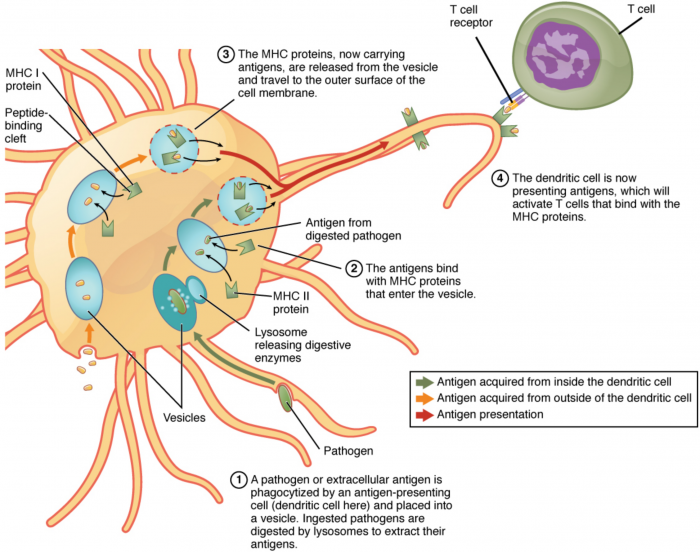 Unlike B cells, T lymphocytes are unable to recognize pathogens without assistance. Instead, dendritic cells and macrophages first engulf and digest pathogens into hundreds or thousands of antigens. Then, an antigen-presenting cell (APC)detects, engulfs, and informs the adaptive immune response about an infection. When a pathogen is detected, these APCs will engulf and break it down through phagocytosis. Antigen fragments will then be transported to the surface of the APC, where they will serve as an indicator to other immune cells. A dendritic cell is an immune cell that mops up antigenic materials in its surroundings and presents them on its surface. Dendritic cells are located in the skin, the linings of the nose, lungs, stomach, and intestines. These positions are ideal locations to encounter invading pathogens. Once pathogens activate them to become APCs, they migrate to the spleen or a lymph node. Macrophages also function as APCs. After phagocytosis by a macrophage, the phagocytic vesicle fuses with an intracellular lysosome. Within the resulting phagolysosome, the components are broken down into fragments; the fragments are then loaded onto MHC class II molecules and are transported to the cell surface for antigen presentation. Helper T cells cannot properly respond to an antigen unless it is processed and embedded in an MHC class II molecule. The APCs express MHC class II on their surfaces, and when combined with a foreign antigen, these complexes signal an invader.
Unlike B cells, T lymphocytes are unable to recognize pathogens without assistance. Instead, dendritic cells and macrophages first engulf and digest pathogens into hundreds or thousands of antigens. Then, an antigen-presenting cell (APC)detects, engulfs, and informs the adaptive immune response about an infection. When a pathogen is detected, these APCs will engulf and break it down through phagocytosis. Antigen fragments will then be transported to the surface of the APC, where they will serve as an indicator to other immune cells. A dendritic cell is an immune cell that mops up antigenic materials in its surroundings and presents them on its surface. Dendritic cells are located in the skin, the linings of the nose, lungs, stomach, and intestines. These positions are ideal locations to encounter invading pathogens. Once pathogens activate them to become APCs, they migrate to the spleen or a lymph node. Macrophages also function as APCs. After phagocytosis by a macrophage, the phagocytic vesicle fuses with an intracellular lysosome. Within the resulting phagolysosome, the components are broken down into fragments; the fragments are then loaded onto MHC class II molecules and are transported to the cell surface for antigen presentation. Helper T cells cannot properly respond to an antigen unless it is processed and embedded in an MHC class II molecule. The APCs express MHC class II on their surfaces, and when combined with a foreign antigen, these complexes signal an invader.
T cells have many functions. Some respond to APCs of the innate immune system and indirectly induce immune responses by releasing cytokines. Others stimulate B cells to start the humoral response as described previously. Another type of T cell detects APC signals and directly kills the infected cells, while some are involved in suppressing inappropriate immune reactions to harmless or “self” antigens.
There are two main types of T cells: helper T lymphocytes (TH) and cytotoxic T lymphocytes (TC). The TH lymphocytes function indirectly to tell other immune cells about potential pathogens.
Cytotoxic T cells (TC) are the key component of the cell-mediated part of the adaptive immune system and attack and directly destroy infected cells. TCcells are particularly important in protecting against viral infections; this is because viruses replicate within cells where they are shielded from extracellular contact with circulating antibodies. Once activated, the TC creates a large clone of cells with one specific set of cell-surface receptors, as in the case with clonal expansion of activated B cells. As with B cells, the clone includes active TC cells and inactive memory TCcells. The resulting active TCcells then identify infected host cells. Because of the time required to generate a population of clonal T and B cells, there is a delay in the adaptive immune response compared to the innate immune response.
TCcells attempt to identify and destroy infected cells before the pathogen can replicate and escape, thereby halting the progression of intracellular infections. TC cells also support NK lymphocytes to destroy early cancers. Cytokines secreted by the TH response that stimulates macrophages also stimulate TCcells and enhance their ability to identify and destroy infected cells and tumors. A summary of how the humoral and cell-mediated immune responses are activated appears below.
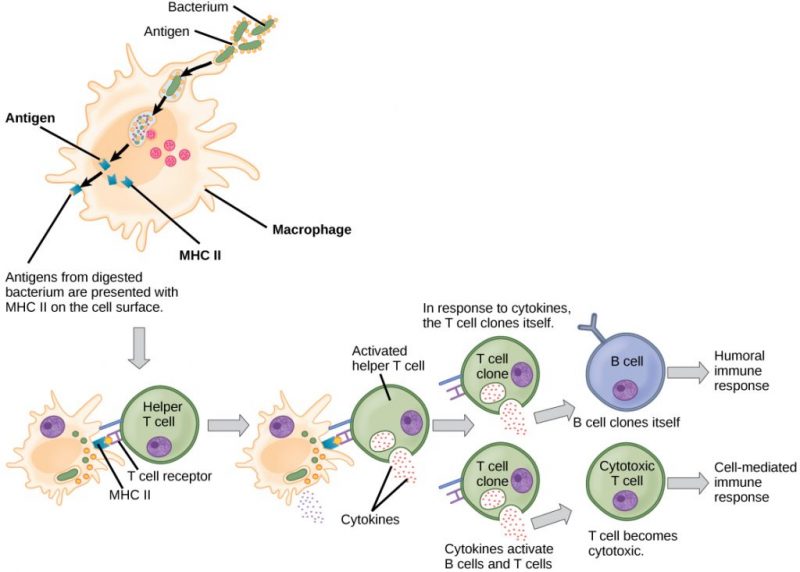
B plasma cells and TC cells are collectively called effector cells because they are involved in “effecting” (bringing about) the immune response of killing pathogens and infected host cells.
The table below summarizes the major cells that carry out the adaptive immune response.
| Cell | Function |
| B lymphocytes (B cells) | Recognize foreign antigens and secrete antibodies |
| T lymphocytes (T cells) | Helper T cells provide signals that promote immune responses; cytotoxic T cells kill target cells |
| Antigen Presenting Cell (APC) | Present antigen to helper T cells and include dendritic cells, macrophages, and B cells |
Learn By Doing 17.7
When the adaptive immune system is functioning, many cells are kicked into high gear. Which cell type is paired with its correct function?
- B cells manufacture antibodies, which are proteins that circulate and bind to foreign antigens.
- T helper cells are needed to act as sentries for mucus membranes.
- Memory T Cells will produce antibodies the next time the foreign pathogen tries to get into the cell.
- Cytotoxic T cells circulate and remove immune cells that are no longer functioning properly.
Complete the paragraph by replacing each number with a selection from its numbered column in the table.
Two lymphocyte populations housed in lymphatic tissue are the___1___. When the immune response is provided by antibodies released to body fluids, the immunity is called humoral or___2___ immunity. When T cells provide protection, the immunity is referred to as ___3___immunity. Both the antibody-mediated and cellular immune responses are considered part of the ___4___immune response.
|
1 |
2 |
3 |
4 |
| B cells and T cells | cell-mediated | humoral | innate |
| B cells and plasma cell | antibody-mediated | cell-mediated | adaptive |
| neutrophils and basophils |
Complete the following paragraph:
Antibody-mediated immunity works mainly against ___1___ pathogens, which include any bacteria, fungi, or viruses that are in the extracellular fluids of the body. B cells respond to unprocessed antigens, but their response is more intense if they process the antigen and receive co-stimulation by___2___ T cells. Once activated, B cells produce clones of ___3___ cells and memory cells which reside in lymphatic tissues (such as lymph nodes and spleen). Plasma cells produce ___4___, which leave the lymphatic tissue and circulate in body fluids.
|
1 |
2 |
3 |
4 |
| extracellular | cytotoxic | plasma | antibodies |
| intracellular | helper | naïve | cytokines |
Describe the difference between active and passive immunity.
Immunological Memory
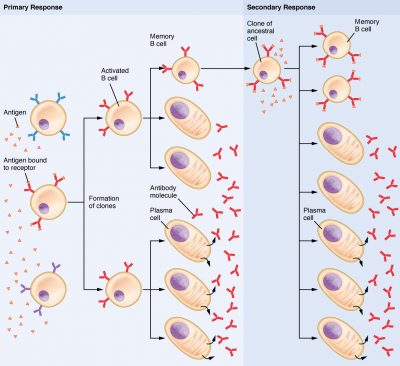 |
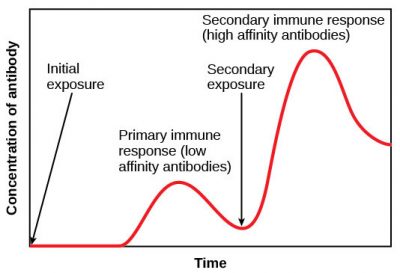 |
The adaptive immune system has a memory component that allows for a rapid and large response upon reinvasion of the same pathogen. During the adaptive immune response to a pathogen that has not been encountered before, known as the primary immune response, plasma cells secreting antibodies and differentiated T cells increase, then plateau over time. As B and T cells mature into effector cells, a subset of the naïve populations differentiates into B and T memory cells with the same antigen specificities. A memory cell is an antigen-specific B or T lymphocyte that does not differentiate into an effector cell during the primary immune response but that can immediately become an effector cell on re-exposure to the same pathogen. As the infection is cleared and pathogenic stimuli subside, the effectors are no longer needed, and they undergo apoptosis. In contrast, the memory cells persist in circulation.
If the pathogen is never encountered again during the individual’s lifetime, B and T memory cells will circulate for a few years or even several decades and will gradually die off, having never functioned as effector cells. However, if the host is re-exposed to the same pathogen type, circulating memory cells will immediately differentiate into plasma cells and TC cells without input from APCs or TH cells. This is known as the secondary immune response. One reason why the adaptive immune response is delayed is that it takes time for naïve B and T cells with the appropriate antigen specificities to be identified, activated, and proliferate. On reinfection, this step is skipped, and the result is a more rapid production of immune defenses. Memory B cells that differentiate into plasma cells output tens to hundreds-fold greater antibody amounts than were secreted during the primary response. This rapid and dramatic antibody response may stop the infection before it can even become established, and the individual may not realize they had been exposed.
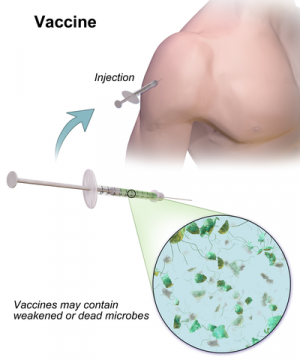
(Credit: Bruce Blaus, CC BY-SA 4.0)
Vaccination is based on the knowledge that exposure to noninfectious antigens derived from known pathogens generates a mild primary immune response. The host may not perceive the immune response to vaccination as an illness, but it still confers immune memory. When exposed to the corresponding pathogen to which an individual was vaccinated, the reaction is similar to secondary exposure. Because each reinfection generates more memory cells and increased resistance to the pathogen, some vaccine courses involve one or more booster vaccinations to mimic repeat exposures.
Learn By Doing 17.8
Why does immunological memory occur?
- When your immune system encounters a new antigen in addition to creating effector cells, it also creates some memory cells which are capable of clonal expansion at a later time.
- We maintain circulating levels of antibodies against every antigen we have ever encountered.
- T cells and B cells which have become specialized for antigenic response live forever.
- Our brain remembers what we have encountered before and tells the cells of the immune system what to do.
Memory cells are an essential part of the adaptive immune response and are the reason a second exposure to the same pathogen is more rapid than the primary response. What cell type can become a memory cell?
- erythrocytes
- phagocytic cell
- T cells only
- T and B cells
Why is the immune response after reinfection much faster than the adaptive immune response after the initial infection?
Summary
The adaptive immune response is a slower-acting, longer-lasting, and more specific response than the innate response. However, the adaptive response requires information from the innate immune system to function. APCs display antigens on MHC molecules to naïve T cells. T cells with cell-surface receptors that bind a specific antigen will bind to that APC. In response, the T cells differentiate and proliferate, becoming TH cells or TC cells. TH cells stimulate B cells that have engulfed and presented pathogen-derived antigens. B cells differentiate into plasma cells that secrete antibodies, whereas TC cells destroy infected or cancerous cells. Memory cells are produced by activated and proliferating B and T cells and persist after primary exposure to a pathogen. If re-exposure occurs, memory cells differentiate into effector cells without input from the innate immune system.
Homeostasis and Homeostatic Imbalances
Learning Objective
The proper functioning of body cells depends on precise regulation of the composition of the interstitial fluid surrounding them. The composition of interstitial fluid changes as substances move back and forth between it and blood and lymph. In addition, some disruptions come from the external environment. Fortunately, the body has mechanisms to try to inhibit foreign substances from entering the internal environment of the body, and if they do get in, immune responses help to remove or neutralize the invader before the disruption leads to disease. Unfortunately, some factors or situations affecting the lymphatic system and immune responses could disrupt homeostasis.
Inflammatory Response and Clinical Disruptions of Homeostasis
Lymph Nodes
Lymph nodes play key roles in the body’s immune function. Lymph nodes filter harmful bacteria and other pathogens from the lymph, preventing them from reaching the blood and circulating throughout the body.
Sometimes, however, the lymph nodes and appendix become overwhelmed by these tasks, resulting in homeostatic imbalance. Lymph nodes can become swollen and tender as the pathogen they are designed to fight infect them and result in inflammation. This is a common symptom of many illnesses and is often (incorrectly) referred to as having “swollen glands.” Swollen lymph nodes often occur behind the ears, on the neck, near the jaw or chin, and in the armpits. Colds, the flu, tonsillitis, ear infections, and mononucleosis are common causes of this swelling. Although pain and tenderness associated with swollen lymph nodes typically diminish within a few days of onset, the swelling can last for several weeks after the onset of infection. After the infection has been eradicated from the body, the lymph nodes return to their normal size.
Appendix
The lymph tissue of the appendix helps control microbes in the colon from moving into the small intestine. Both of these structures activate the immune system to mount an attack against these pathogens.
Acute inflammation of the appendix, termed appendicitis, can be preceded by a number of possible causes. It is characterized by pain, high fever, and increased white blood count. The infection results in edema and ischemia and my progress to gangrene and perforation within 24 hours. Removal of the appendix may be recommended.
Ruptured SpleenCan Create Homeostatic Imbalances
Homeostatic imbalances can also afflict the spleen, another lymph organ. Although the ribs protect the spleen from trauma, direct blows to the left upper abdominal area or even severe infection can result in rupture. When this happens, the spleen spills blood into the peritoneal cavity. As a result, it has been customary for such injuries to result in splenectomy or total removal of the spleen to prevent excessive blood loss or further infection. In recent years, however, it has been found that the spleen has a significant capacity for self-repair. As a result, splenectomies have become less common, as doctors elect to leave part or all of damaged spleens in patients in the hopes the tissue will repair itself. In severe cases, when the spleen has completely ruptured and/or there is a high risk of infection, the spleen is still removed. The liver and bone marrow take over many of the spleen’s functions, although immune responses may be less robust in individuals without spleens.
Graft Versus Host Disease and Transplant Rejection
A bone marrow transplant is a procedure in which damaged or destroyed bone marrow (the soft, flexible tissue inside bones) is replaced with healthy bone marrow stem cells from a donor. Bone marrow is important because it is where blood cells—including lymphocytes—are produced. When bone marrow stem cells become damaged as a result of certain types of cancer, chemotherapy, aplastic anemia, or other diseases, a bone marrow transplant or stem cell transplant is needed so that the body can continue to produce blood cells.
Graft versus host disease (GVHD) occurs when a patient receives a stem cell or bone marrow transplant from someone who is not closely histocompatible. The transplanted material attacks the recipient’s body. As mentioned previously, bone marrow contains stem cells that produce white blood cells and other immune system cells. No two people, except identical twins, have the same tissue type. Therefore, each individual expresses unique proteins on their cells that are a unique subset of major histocompatibility complex (MHC) proteins. These unique proteins help signal to the T and B cells that the cells are yours and should not be attacked and destroyed. When a person receives a bone marrow transplant, they are receiving someone else’s immune cells. These cells may not recognize the host cells as their own. As a result, the new immune cells can attack the host cells, resulting in fever, weight loss, pain, rashes, and of primary concern, the patient becomes more vulnerable to infection. Immunosuppressant medication is typically given to patients in order to reduce the chances of GVHD developing. If GVHD does occur, it is treated with high doses of corticosteroids. GVHD occurs in about 30–40% of patients who receive donations from relatives and 60–80% of patients for whom the donor is not a relative.
Transplant rejection is a process in which the recipient’s immune system attacks a transplanted organ or tissue. For example, a person receiving a new kidney will require immunosuppressant drugs to prevent their immune cells from attacking and destroying the new, foreign kidney. Transplant rejection can be lessened by determining the MHC similarities between the donor tissue and the transplant recipient and trying to match them as closely as possible. Rejection is a cellular immune response via cytotoxic T cells inducing lysis of transplanted cells as well as an antibody-mediated response via activated B cells secreting antibodies. The actions of the adaptive immune responses are joined by components of innate immune responses via phagocytes and soluble immune proteins.
Learn By Doing 17.9
Unless someone is an identical twin, they have a unique configuration of proteins on the surfaces of the cells. These proteins termed___________________ are inherited from your parents., However, you only get a few from each parent, not the full range the parent has. Consequently, siblings may not have exactly identical ________________ meaning they will not always be a _______________ for a transplant. This group of proteins is different from your ________________ which is a different group of proteins found on your red blood cells.
- sister chromatids, tissue types, compatible donor, Rh factor
- major histocompatibility complex antigens, tissue type, compatible donor, blood type
- blood proteins, transplant type, incompatible donor, donor ID
- major histocompatibility complex antigens, blood type, compatible donor, blood type
Imbalances of Immune Function
Autoimmune Disorders
Finally, a homeostatic imbalance can occur if the immune system fails to distinguish self from non-self, resulting in an attack on cells and organs by auto-antibodies and self-reactive T cells. The autoimmune disease appears to be caused by the failure of the tolerance processes to protect the host from the action of self-reactive lymphocytes. In an organ-specific autoimmune disease, the immune response is directed to an epitope unique to a single organ or gland. Hashimoto’s thyroiditis, insulin-dependent diabetes mellitus (pancreas), myasthenia gravis (acetylcholine receptors on muscles) and Crohn’s disease (GI) are examples of organ-specific autoimmune diseases. Autoimmune diseases can also be directed toward a broad range of epitopes and involve a number of organs and tissues. Systemic lupus erythematosus, multiple sclerosis, and rheumatoid arthritis are examples of systemic autoimmune diseases. A variety of mechanisms have been proposed for the induction of autoimmunity, and evidence exists for each of these mechanisms. Indeed there may be different pathways leading to autoimmune reactions. Current treatments include immunosuppressive drugs, thymectomy, and plasmapheresis for diseases involving immune complexes. Also, blockers of some cytokines show success in several autoimmune diseases.
Systemic Lupus Erythematosus (SLE), or lupus, is an autoimmune disease that results from an improper immune cell balance. It is a chronic inflammatory immune disorder that results from an increase in a subset of helper T cells and an improper activation of B cells and macrophages. This results in the activation of B cells that produce antibodies targeting the nucleic acids in the cells of several organs in the body. Depending on the B cells that are activated, many different locations can be affected including the brain, digestive tract, heart, lungs, skin, or kidneys. Arthritis in the joints is a common symptom in patients with SLE.
SLE is more prevalent in women than in men. Symptoms can arise between the ages of 10 to 50 and range in severity. Depending on the affected organ, symptoms can include chest pain, headache, migraine, fever, fatigue, vomiting, arrhythmias, malaise, hair loss, mouth sores, and the characteristic butterfly skin rash. This rash occurs in about 50% of all cases. The cause (etiology) of SLE is still unknown and an active area of research. There is no cure for SLE, but in most patients, the disease can be managed, and the outcome (prognosis) for patients has been improving over the years.
Acquired Immunodeficiency Syndrome (AIDS)is caused by the retrovirus, the human immunodeficiency virus (HIV). HIV infects T cells. These TH cells are also called CD4+ cells because of the presence of the CD4 protein on their surface. Once inside the cell, HIV hijacks the host transcriptional machinery to replicate the virus nucleic acids. After the nucleic acids have been replicated, the synthesis of virus proteins can occur. These newly synthesized viruses exit the cell and infect another T cell. In the process, HIV destroys the CD4+ cells in the body. Once this population of immune cells is removed, the immune system of an infected person can no longer function properly.
Lymphoma
There are many types of cancer that affect either T or B cells. These are collectively called lymphomas. More than 30 types of lymphomas have been detected. Some are aggressive and fast-growing lymphomas, while others are less aggressive and slow growing. Lymphomas can arise at any age and occur within the germinal centers of lymph organs and nodes.
Allergy
An allergy or hypersensitivity reaction is an immune reaction to agents that are not normally harmful. These could be substances like strawberries, pollen, cat dander, or cockroach casings. Immediate hypersensitivities are allergic reactions that require prior exposure to the antigen. In this first exposure helper T cells produce IL-4, which drives the plasma cells to produce antibodies. Antibodies bind to receptors present on mast cells. Once enough antibodies are present on mast cells, exposure to the same antigen induces mast cells to respond with an inflammatory response that releases histamine, a chemical that increases the dilation of the lymph and blood vessels. In addition, histamine produces watery eyes, an itchy nose, and a cough. Delayed hypersensitivities take hours to days to develop and are caused by T cells. The most common types result from contact of a substance with the skin or mucous membranes. For example, poison ivy, soaps, and drugs can cause a delayed hypersensitivity reaction. The substance is absorbed by the epithelial cells, which are then destroyed by T cells. The inflammation and tissue destruction cause intense itching.
Learn By Doing 17.10
Dysfunction of the lymphatic system seems to occur around one of two basic mechanisms; either the cells of the immune system respond to something which they should not, or the cells lose their ability to function as they normally would. Which pairing with disease and mechanisms is correct?
- HIV infection causes the immune cells to make too many antibodies.
- Diabetes results from immune cells no longer making insulin.
- Allergic reactions happen when the cells of the immune system respond to normal environmental elements.
- Autoimmune diseases happen when T cells divide too rapidly.
Rheumatoid arthritis occurs when the immune system of the body attacks some of the structures found in the synovial joints. It often becomes a downward spiral. The autoimmune attack on the joint leads to the degradation of the joint. Degradation of the joint stimulates the immune system even more so there is a further attack on the joint. What approach might be the best for getting this process under control?
- Give the patient antihistamines.
- Give the patient some drugs which would temporarily reduce the activity of their immune cells.
- Give the patient antibiotics.
- Look for a suitable donor to do a bone marrow transplant
Immune Integration of Systems
Learning Objective
All of the systems of the human body functioning together comprise the total human organism, the highest level of organization. All body systems influence and interact with one another. They work together to maintain health and provide protection from disease. Fluid balance allows for healthy circulation of substances throughout the body, optimal distances for the diffusion of ions and molecules, and proper ion concentration for excitable tissues. In addition, the lymphatic system helps protect the whole organism from the external invasion of foreign substances into the body that may cause disease and also removes damaged or worn-out body cells as a normal component of tissue repair and maintenance.
The following table highlights some of the lymphatic system’s interactions with several other body systems.
| Body System | Immune System Support | Immune System Benefits/Effects |
| Cardiovascular | Returns filtered fluids and proteins to blood preventing interstitial edema and loss of plasma volume. | Provides transport for white blood cells from the site of their origin to their effector site. |
| Endocrine | The thymus gland produces hormones that regulate T cell maturation | Hormones coordinate leukopoesis; Cortisol is an immune suppressant |
| Nervous | Source of microglial cells which remove debris from CNS. Cytokines promote sleep; cytokines target temperature regulation setpoint in the hypothalamus during fever production | Sleep optimizes immune response; the hypothalamus resets body temperature during fever production to enhance immune response; the hypothalamus releases corticotropin which activates the pathway for cortisol release which has anti-inflammatory effects |
| Reproductive | Antibodies cross the placenta providing passive immunity to the fetus and antibodies in the mother’s milk provide passive immunity to newborn | The immune system undergoes important modifications during pregnancy; critical that the mother tolerate the fetus (foreign graft); sex hormones may be anti-inflammatory but may exacerbate antibody-mediated autoimmunity |
| Respiratory | MALT, alveolar macrophages, inhibit pathogens that penetrate mucous and alveolar membranes | Gas exchanges in the lungs provide oxygen to lymphatic cells and remove waste carbon dioxide from these cells necessary for the viability of cells |
| Skeletal | Osteoclast, which helps regulate calcium balance, is derived from monocyte | Red bone marrow is the site of white blood cell formation |
| Integumentary | Leukocytes remove pathogens and help wound repair | Anatomic and chemical barrier component of innate body defenses |
| Urinary | MALT helps defend against pathogens | Urine flow helps prevent pathogen entrance into the body as part of innate immunity |
| Digestive | MALT inhibits pathogens that penetrate mucous membranes | Provides nutrients for lymphoid organs; gastric acidity is a component of innate immunity |
*
“Learn By Doing” and “Did I Get This?” Feedback
Learn By Doing 17.1
Fact or myth? Read the statements below and see what you think. Once you’ve made your choices, check the feedback at the end of the chapter.
- Lymph accumulates toxic waste products over time, so it is recommended to do lymph cleansings regularly.
Myth: Lymph transports fats and liquids, and also contain white blood cells, but its role is not waste transport. Websites promoting lymph cleansing are not based on science! - The human immune system has the ability to make up 109 different antibodies.
Fact: The Lego-like structure of the genes that code for antibodies can be “mixed and matched” into an amazing set of combinations. - The younger we are, the stronger our immune system is.
Myth: Newborn babies have only innate immunity and rely for protection on antibodies provided by the mother through the placenta and via breast milk. - Vaccines can cause autism.
Myth: The one study this belief was based on has been proven manipulated and has since been retracted. Many other studies have found no correlation between vaccination and autism. - One of the most remarkable features of the immune system is its ability to respond to an apparently limitless array of foreign antigens.
Fact: Although only a small fraction of the potential repertoire of B cell receptors is displayed in circulation at any one time, these cells have the capacity to generate greater than 1010 possible antibody–pathogen combining sites. - When you begin to experience the flu or cold symptoms, it is wise to take extra doses of vitamins C and zinc to boost your immune system.
Myth: It is true that malnourished or undernourished individuals have noticed a “boost” in their immune response when supplements of vitamin C and A and the mineral zinc have been added to their daily diets. However, no evidence has been shown to indicate that increases above the normal physiologic values have improved immune function and in the case of vitamin A can actually prove harmful. - Only healthy individuals should get the flu shot because you could get the flu from the vaccination.
Myth: The flu shot only exposes the recipient to fragments of the virus that are incapable of infecting and reproducing in the body. Mild symptoms of the immune response, such as chills, fever and general malaise may be experienced. There is a nasal vaccination against the influenza virus that exposes an individual to “live” but weakened virus particles which may be able to infect the individual but incapable of reproducing in the body. This vaccine is only given to young healthy adults.
Learn By Doing 17.2
Immunity requires a variety of fully functioning cells to provide the best protection. When someone is undergoing chemotherapy, they often experience a decrease in their immune functions as a result of their treatment. Since the cell is the basic unit of life, which of the following is most likely affected?
- Chemotherapy inhibits the growth of immune cells by reducing their ability to produce needed molecules.
Incorrect. Chemotherapy kills cells by attacking the machinery the cell needs to replicate its DNA and keep its membrane intact. If chemotherapy doesn’t kill a cell, the cell is likely to carry out its normal growth pattern. - Living things reproduce themselves and chemotherapy inhibits the ability of some key cells such as lymphocytes and the epithelium of mucus membranes to divide quickly in response to damage and/or invaders.
Correct. Chemotherapy kills rapidly dividing cells. The immune system relies of the integrity of the epithelial membranes and the ability of the lymphocytes to reproduce and clonally expand. - Living things have complex structures and chemotherapy results in the evolution of cells which are highly simplified.
Incorrect. Chemotherapy may alter the differentiation pathway of some stem and pluripotent cells, but it does not make the cell any less complex. - Living things need to be able to undergo metabolism, and chemotherapy starves the cells.
Incorrect. Patients undergoing chemotherapy often have difficulty maintaining adequate nutrition this is because the absorptive cells of their digestive system are being killed and sloughed away. Chemotherapy does not alter the cells’ ability to get nutrients.
The immune system monitors and provides information about the external world as well as the changes and perturbations of the body’s internal environment. In addition to immune reactions, the inflammatory process prevents further internal damage and promotes repair. How are these responses triggered? Pick the best answer.
- In response to noxious stimuli such as extreme heat or cold, damaged cells and immune surveillance cells initiate a local inflammatory response.
Incorrect. This is an example of one way in which the external environment impacts the body, and the body uses signals to try to limit the damage. - Damaged tissues found internally such as ruptured endothelial cells or torn muscles and ligaments release chemical signals in the local area which stimulate nearby cells to trigger an inflammatory response.
Incorrect. Damaged tissues send out a variety of signals to stimulate changes in the local environment to aid wound repair and prevent further damage. - Bacterial toxins released into the bloodstream circulate throughout the body and reach the brain where they stimulate systemic responses such as fever, fatigue, anorexia, and irritability.
Incorrect. Fever, malaise, fatigue, and loss of appetite are often experienced even with a localized bacterial infection. - One of 1, 2, or 3 is incorrect.
Incorrect. A, B, and C are all examples of communication and signaling within the body which monitor changes in both the internal and external environment. - 1, 2, and 3 are all correct.
Correct. These are all examples of communication and signaling within the body which monitor changes in both the internal and external environment.
The phrase “You are what you eat” has been bantered around for a long time. In terms of immune functions, why would what you eat matter?
- The lymphatics in the digestive system called lacteals pick up the fats you have eaten and degrade them so that you don’t get too many calories.
Incorrect. The lacteals do indeed pick up fats which ultimately end up in the liver to be processed with the other molecules you may have ingested. - Actually, it doesn’t matter; even people who are malnourished have adequately functioning immune systems.
Incorrect. People who are malnourished often have immune systems which function at a much lower level. - All of the body’s cells and tissues need energy to grow, repair themselves and reproduce. Without ingesting adequate amounts of fuel, the cells of the lymphatic system would not be able to make antibodies, cytotoxic T cells, or maintain the integrity of physical and chemical barriers.
Correct. All aspects of your body’s defense mechanisms require fuel. - If you eat too many high-fat foods, the cells in the immune system turn into adipocytes.
Incorrect. As you age the cells in your thymus become replaced by fat cells but immune system cells do not differentiate into fat cells.
Learn By Doing 17.3
Our Answer: “Host” refers to the organism that is infected while “pathogen” refers to the disease-causing organism or virus.
Learn By Doing 17.4
What are two main differences between innate and adaptive immune responses?
- Inflammatory response and lysis of pathogens by phagocytic cells.
Incorrect. Both of these immune responses are categorized as innate responses. - Time of the immune response due to the immunologic specificity and immunologic memory.
Correct. These are the two main differences between innate and adaptive immune responses. - The cells involved and the location of responses.
Incorrect. Although different cells are categorized into innate and adaptive immunity, both innate and adaptive cells respond to pathogens in the same locations of the body. - Adaptive responses occur in the lymph node while innate responses occur in the blood.
Incorrect. Adaptive and innate responses both occur in the lymph nodes, and the blood transports both adaptive and innate cells to tissues where they will respond to pathogens.
It is useful to think about the immune system in terms of those aspects with which we are born and those that we acquire later referred to as acquired or adaptive immunity. Which of the processes below do not fit into the category of innate immunity?
- Destruction of an invading organism by the complement system
Incorrect. The complement system is part of the innate immune response. - Manufacturing antibodies as the result of getting a vaccination
Correct. Making antibodies (also known as immunoglobulins) is part of the adaptive immune response. - Phagocytosis of foreign invaders by macrophages or other cells
Incorrect. Phagocytosis by macrophages, neutrophils, and other cells is part of the innate immune system. - Mechanical and chemical barriers such as sticky mucus membranes and your tears.
Incorrect. Barriers to infection are considered part of the innate immune system.
Learn By Doing 17.5
Immunity is resistance to disease resulting from the presence of foreign substances or antigens in the body. If a pathogen gets past the physical and chemical barriers of the innate immune system, macrophages can ingest and degrade the substance. This process is called phagocytosis. Because pathogens are likely to use both blood and lymph as a means of getting around in the body, the lymph tissues and organs are in an excellent position to detect their presence.
|
1 |
2 |
3 |
4 |
5 |
| antibodies | chemical | lymphocytes | inflammation | air |
| antigens | physical | macrophages | phagocytosis | lymph |
| cytokines | physical and chemical barriers | NK cells | margination | saliva |
Which of the following cells would be most active in early, anti-viral immune responses the first time one is exposed to a pathogen?
- macrophage
- T cell
- neutrophil
- natural killer cell
Complete the paragraph by replacing each number with a selection from a numbered column in the table.
Complement is a system of plasma proteins that circulate in the blood in an inactive form. Complement is activated when it becomes attached to the surface of foreign cells (bacteria, fungi, red blood cells). One result of this complement fixation is that holes or pores appear in the membrane of the foreign cell. This allows extracellular fluid to rush into the cell, which causes lysis of the foreign cell. Some of the molecules released during complement fixation enhance phagocytosis. Other molecules amplify the inflammatory response.
|
1 |
2 |
3 |
4 |
5 |
| carbohydrates | denatured | holes or pores | water | apoptosis |
| lipids | inactivated | new mRNA or proteins | extracellular fluid | dehydration |
| steroids | activated | self markers (antigens) | sodium | cell division |
| proteins | digested | molecular bridges & cross-linking | white blood cells | lysis |
We often take over-the-counter anti-inflammatory medicines to help us feel better when we are sick or injured. However, the inflammatory response is important after injury in our fight against infection and tissue repair and recovery. Which statement is NOT true concerning the inflammatory response?
- Heat and redness indicate that your inflammatory response is out of whack and the tissue will not heal.
Correct. This statement is false. Heat and redness are part of the increased vasodilation in the affected area. It means the inflammatory response is working. - Pain reminds us to get an injured or infected body part immobile, so we don’t spread the infection or exacerbate the injury.
Incorrect. This statement is true. Pain does help remind us to immobilize an area, so the body can use the most resources to fight infection and heal. - Increasing body temperature via fever makes it difficult for some organisms to grow.
Incorrect. This statement is true. Many pathogens have a very limited temperature range where they can grow well. Fever’s increasing body temperature may impede pathogen growth. - Swelling and edema provide a more fluid environment, which allows white blood cells easier access to the site of infection or injury.
Incorrect. This statement is true. Swelling and edema are important for cell motility.
Innate immunity describes immunity that is non-specific to the pathogen or invading organism. Which of the following mechanisms are ALL considered innate immunity?
- Fever, the inflammatory reaction, antibody production
Incorrect. Antibody production is an adaptive response. - Inflammatory response, phagocytosis, fever
Correct. All of these processes are innate mechanisms in addition to anatomic barriers. - Sequestering of pathogens, anatomical barriers, phagocytosis
Incorrect. Pathogen sequestration may occur as part of either the innate or adaptive responses. - Antibody production, fever, anatomical barriers, the inflammatory process
Incorrect. Antibody production is part of the acquired immune response.
Describe the innate immune response to bacteria that enters through a cut on the skin.
Our Answer: The first obstacle that bacteria must overcome is the skin. Entry through a cut in the skin allows for such access. When it enters, the pathogen-associated molecular patterns (PAMPs) found on the surface of the bacteria are recognized by the local immune cells. Mast cells begin to release chemicals to recruit other immune cells, then macrophages or neutrophils will phagocytize the bacteria and lyse it. The area of infection shows signs of infection. It will become hot, red, swollen, and become painful because of the influx of inflammatory cells.
Why is it beneficial to have an innate immune response?
Our Answer: The innate immune response is very rapid. Signs of infection and inflammation are evident within minutes of exposure. The innate immune response will either prevent or diminish the potential damage that can result if a pathogen gains access to the body.
Learn By Doing 17.6

In the diagram, where do pluripotent WBC stem cells come from?
- A: Incorrect. This is the thymus which is important for T cell maturation.
- B: Correct. The bone marrow contains pluripotent stem cells.
- C: Incorrect. This is the spleen; it functions to store mature white blood cells and serves as a reservoir for blood and red blood cells.
- D: Incorrect. Gut-associated lymphoid tissue (GALT) is diffuse active tissue.
- None of these choices: There is a correct answer.
In the diagram, where do T cells mature?
- A: Correct. T cells lines must spend some time in the thymus as part of the body’s MHC recognition system, which helps discern self from non-self.
- B: Incorrect. The bone marrow contains pluripotent stem cells, which are not yet capable of immune function.
- C: Incorrect. The white pulp of the spleen contains mature lymphocytes
- D: Incorrect. GALT is diffuse lymph tissue containing mature cells.
- None of these choices: There is a correct answer.
Where are T cell receptors that are self-directed deleted?
- thymus Correct. T cells lines must spend some time in the thymus as part of the body’s MHC recognition system, which helps discern self from non-self.
- lymph node
- lymph capillary
- bone marrow
Learn By Doing 17.7
When the adaptive immune system is functioning, many cells are kicked into high gear. Which cell type is paired with its correct function?
- B cells manufacture antibodies, which are proteins that circulate and bind to foreign antigens.
Correct. B cells make antibodies that respond to a molecule, usually a protein found on the surface of a foreign invader. - T helper cells are needed to act as sentries for mucus membranes.
Incorrect. T helper cells interact with other cells of the immune system to stimulate an adaptive immune response. They circulate freely within the entire body. - Memory T Cells will produce antibodies the next time the foreign pathogen tries to get into the cell.
Incorrect. Memory B cells respond by clonal expansion followed by antibody production. T cells do not make antibodies. - Cytotoxic T cells circulate and remove immune cells that are no longer functioning properly.
Incorrect. Cytotoxic T cells are capable of directly attacking foreign invaders; they do not do “garbage removal.
Complete the paragraph by replacing each number with a selection from its numbered column in the table.
Two lymphocyte populations housed in lymphatic tissue are the B cells and T cells. When the immune response is provided by antibodies released to body fluids, the immunity is called humoral or cell-mediated immunity. When T cells provide protection, immunity is referred to as cell-mediatedimmunity. Both the antibody-mediated and cellular immune responses are considered part of the adaptive immune response.
|
1 |
2 |
3 |
4 |
| B cells and T cells | cell-mediated | humoral | innate |
| B cells and plasma cell | antibody-mediated | cell-mediated | adaptive |
| neutrophils and basophils |
Complete the following paragraph:
Antibody-mediated immunity works mainly against extracellular pathogens, which include any bacteria, fungi, or viruses that are in the fluids of the body. B cells respond to unprocessed antigens, but their response is more intense if they process the antigen and receive co-stimulation by helper T cells. Once activated, B cells produce clones of plasma cells and memory cells which reside in lymphatic tissues (such as lymph nodes and spleen). Plasma cells produce antibodies, which leave the lymphatic tissue and circulate in body fluids.
|
1 |
2 |
3 |
4 |
| extracellular | cytotoxic | plasma | antibodies |
| intracellular | helper | naïve | cytokines |
Describe the difference between active and passive immunity.
Our Answer: In active immunity, the person’s own immune system generates the response to the pathogen. Since this process leads to the creation of memory cells, this form of protection is longer lasting than that provided by the passive reception of antibodies.
Learn By Doing 17.8
Why does immunological memory occur?
- When your immune system encounters a new antigen in addition to creating effector cells, it also creates some memory cells which are capable of clonal expansion at a later time.
Correct. Part of an initial immune reaction is to create memory cells that can respond upon later exposure to the same antigen. - We maintain circulating levels of antibodies against every antigen we have ever encountered.
Incorrect. If this were true, our plasma would be too thick to pass through our blood vessels. - T cells and B cells which have become specialized for antigenic response live forever.
Incorrect. T and B cells do not live forever although memory cells may live for years. - Our brain remembers what we have encountered before and tells the cells of the immune system what to do.
Incorrect. Your brain does not direct your immune response.
Memory cells are an essential part of the adaptive immune response and are the reason a second exposure to the same pathogen is more rapid than the primary response. What cell type can become a memory cell?
- erythrocytes
- phagocytic cell
- T cells only
- T and B cells
Why is the immune response after reinfection much faster than the adaptive immune response after the initial infection?
Our Answer: If the host is re-exposed to the same pathogen type, circulating memory cells will immediately differentiate into plasma cells and cytotoxic T cells without input from APCs or TH cells.
Learn By Doing 17.9
Unless someone is an identical twin, they have a unique configuration of proteins on the surfaces of the cells. These proteins termed major histocompatibility complex antigens are inherited from your parents., However, you only get a few from each parent, not the full range the parent has. Consequently, siblings may not have exactly identical tissue types meaning they will not always be compatible donors for a transplant. This group of proteins is different from your blood type which is a different group of proteins found on your red blood cells.
- sister chromatids, tissue types, compatible donor, Rh factor
- major histocompatibility complex antigens, tissue type, compatible donor, blood type
- blood proteins, transplant type, incompatible donor, donor ID
- major histocompatibility complex antigens, blood type, compatible donor, blood type
Learn By Doing 17.10
Dysfunction of the lymphatic system seems to occur around one of two basic mechanisms; either the cells of the immune system respond to something which they should not, or the cells lose their ability to function as they normally would. Which pairing with disease and mechanisms is correct?
- HIV infection causes the immune cells to make too many antibodies.
Incorrect. HIV infection targets a subgroup of T cells and may eventually kill them. - Diabetes results from immune cells no longer making insulin.
Incorrect. Diabetes occurs when the cells of the immune system attack the beta cells in the pancreas that make insulin. - Allergic reactions happen when the cells of the immune system respond to normal environmental elements.
Correct. An allergic reaction occurs when someone responds to something in the environment that should not stimulate a reaction normally. - Autoimmune diseases happen when T cells divide too rapidly.
Incorrect. Autoimmune diseases occur when the immune cells in the body attack other parts of the body.
Rheumatoid arthritis occurs when the immune system of the body attacks some of the structures found in the synovial joints. It often becomes a downward spiral. The autoimmune attack on the joint leads to the degradation of the joint. Degradation of the joint stimulates the immune system even more so there is a further attack on the joint. What approach might be the best for getting this process under control?
- Give the patient antihistamines.
Incorrect. Antihistamines help to control the inflammatory response associated with an allergic reaction. They will not be much help here. - Give the patient some drugs which would temporarily reduce the activity of their immune cells.
Correct. Giving the patient medicine to reduce the level of their immune response may stop any further damage and give the joint time to heal. - Give the patient antibiotics.
Incorrect. Antibiotics work on bacteria that are foreign invaders. Autoimmune diseases arise from the body attacking itself. - Look for a suitable donor to do a bone marrow transplant
Incorrect. A bone marrow transplant is used to restore immune function if the cells of the immune system have died or can no longer function. It replaces all of the individual’s immune cells.
